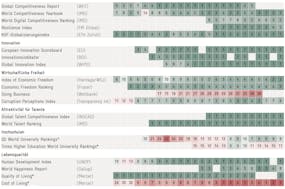Switzerland does not have to break its accords with the European Union on the free movement of persons to meet the aims of the “Masseneinwanderungsinitiative” (the successful February referendum on limiting immigration, ed). Instead, immigration could be curbed bindingly and durably by a 10 year “overall target” (ie. cap) on net movement. Or Switzerland could determine the number of its residents should, by 2025, not exceed a given level. If an interim assessment in 2021 showed growth was getting out of hand, pre-defined measures (quotas) would kick in. That would give Swiss business strong incentives to restrict numbers and politicians would be obliged not to stoke immigration artificially. In this way, Switzerland could probably manage to avoid abrogating its bilateral treaties with the EU while still cutting immigration and avoiding excessive bureaucracy.Avenir Suisse believes Swiss voters are not fundamentally against immigration, in spite of the February 9 referendum. Switzerland has actually benefitted from measured immigration over recent decades and successfully assimilated various waves of newcomers. Likewise, Swiss voters have repeatedly come out in favour of the bilateral treaties with the EU. Immigration-related problems in the labour market have largely failed to materialise: unemployment has not risen, wages have not dropped and there have been growing opportunities for Swiss workers.What worries Swiss voters is not immigration per se, but the speed of recent economic growth. The introduction of free movement of persons with the EU undoubtedly boosted population growth. Between 2002 and 2013, the number of permanent residents (Swiss and foreign nationals) rose by an average 70,000 a year, and between 2007 and 2013 by as much as 90,000 annually. By contrast, population growth in the preceding 20 years lay between 40,000–50,000 annually. The acceleration led to a certain “growth fatigue” – not least because symptoms, like more expensive housing and fewer dwellings, more traffic, or overcrowding and urban sprawl, were (too simplistically) blamed exclusively on immigration and economic growth, rather than misguided policies in dealing with them. Avenir Suisse reckons such factors largely explain majority support for the recent referendum.
A limit to growth, rather than bureaucracy
Avenir Suisse suggests how net immigration (immigration minus emigration) could be lowered without ditching the free movement of persons or the bilateral treaties. Switzerland could decide that its number of permanent residents should not grow to more than, say, 8.84 million or 9m by the end of 2025. Assuming moderate net new births of 17,000 a year, that would leave room for annual net immigration of about 40,000-55,000. That range would be lower than average net immigration since the introduction of free movement in 2002 (average annual net immigration between 2002 and 2013 amounted to 61,000). It would also be significantly below the average of about 75,000 in the peak immigration years 2007-2013. Avenir Suisse’s proposal of an “overall target“ covering 10 years would not, however, depend on precise annual numbers. And an alternative would be to set a 10 year immigration goal. To ensure flexibility, the targets for 2026-2035 could be recalibrated before 2024. The principle of free movement would be maintained.

The idea of quotas creates the right incentives
In 2021, five years after the proposed new rules, a balance could be drawn. If immigration exceeded pre-determined levels, special measures would kick in automatically from 2021. These would involve fixed quotas, ensuring the long term target was not overshot. They could be set either centrally or (making more sense economically) be auctioned off. The latter would provide a strong incentive to both business and politics to act cautiously, as fixed quotas are inflexible, inefficient and subject to red tape. To prevent free-riding (for example by companies exploiting the initial period of unlimited immigration to hire unlimited foreign workers), the potential quota system that would include a retroactive element allowing some clawback. By allowing a degree of annual flexibility, Avenir Suisse’s proposal would aim to reduce net immigration without breaching the principle of free movement. The single constraint would be that, in 2021 or 2025, immigration should remain within the predetermined limits.
The advantages of overall targets
The proposal has five important benefits:
- Swiss politicians and businesses would gain time to adjust to the new circumstances.
- The threat of drastic measures would create a strong incentive to self regulation (in the sense of avoiding unnecessary foreign hirings, ed). Meanwhile, politicians would be obliged not to stoke immigration artificially.
- Unnecessary red tape and the risk of friction between industries and regions over access to foreign labour would be avoided.
- Flexible adjustments could be made based on economic cycles or other outside factors. If the economy slowed, for example, the pressure of immigration would decline anyway and quotas would be redundant.
- The threat of radical curbs is not the same as breaching the principle of free movement. So the bilateral treaties would probably not be endangered.
A package of measures for business and politics
Switzerland can only influence so called “pull factors“ driving immigration. By contrast, “push factors“ are given. So Avenir Suisse’s proposed “target“ system would need various accompanying measures to lower immigration without triggering quotas. Those measures would affect both the federal government and the cantons, as well as companies and business federations.
Measures for Business:
- Greater efforts to mobilise reserve capacity in the Swiss labour market (women, older people), better opportunities to combine work and family life, flexible working hours for older people, mentoring models.
- Finance for such changes to come from a voluntary levy on companies, collected via their trade associations, for every foreign hire (during the first three years of work or as an upfront payment on employment). Such measures would increase the cost of hiring foreigners relative to Swiss residents.
Measures for Politics
- Eliminating location policy, except for the most structurally weak regions
- Eliminating targeted tax holidays to attract new companies – while maintaining the best possible conditions for all firms.
- A more restrictive approach to land zoning for industry and commerce.
- Eliminating the disadvantage for second income earners in taxation and social and family policy (child care fees).
- Education policy to be targeted more closely to the labour market, e.g. jobs focused on mathematics, IT, science and technology (so called MINT-Berufe in German, ed).
- Lower quotas for non EU immigrants.
- Restrictions on residence permits for additional family members for non EU immigrants.
- Cross border commuters (foreign nationals coming daily to work in Switzerland, ed) are not the problem, but part of the solution.
It is essential such commuters not be regarded as immigrants. They are not taking up residence, but living in their home countries, so they are not demanding living space or bringing family members. Nor do they have any significant demands on Swiss infrastructure, other than transport. Avenir Suisse is convinced cross border commuters could be an important part of the solution.
Target
- The concrete targets for net immigration in relation to Switzerland’s population from 2016 to end 2025 should be determined by politicians. The following variants may be of value as an indication:
- The “low variant” would reduce immigration to levels seen at the introduction of free movement between 2002 and 2006. Based on average net annual immigration of 40,000, the population by the end of 2025 would probably reach 8.84 million.
- The “high variant“ is based on net immigration slightly under the levels of 2007-2013 (when free movement gathered pace). Based on average net annual immigration of 70,000, the population by the end of 2025 would probably reach 9.14m.
The “mid variant” is based on net immigration of 55,000 a year – corresponding roughly to the full 2002-2013 period. That would lead to a probable end 2025 population of 8.99m.





